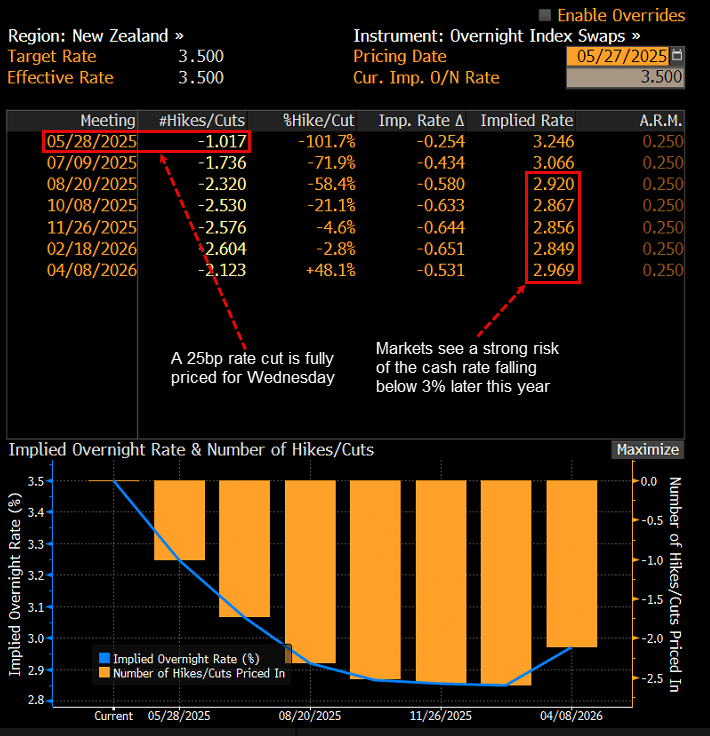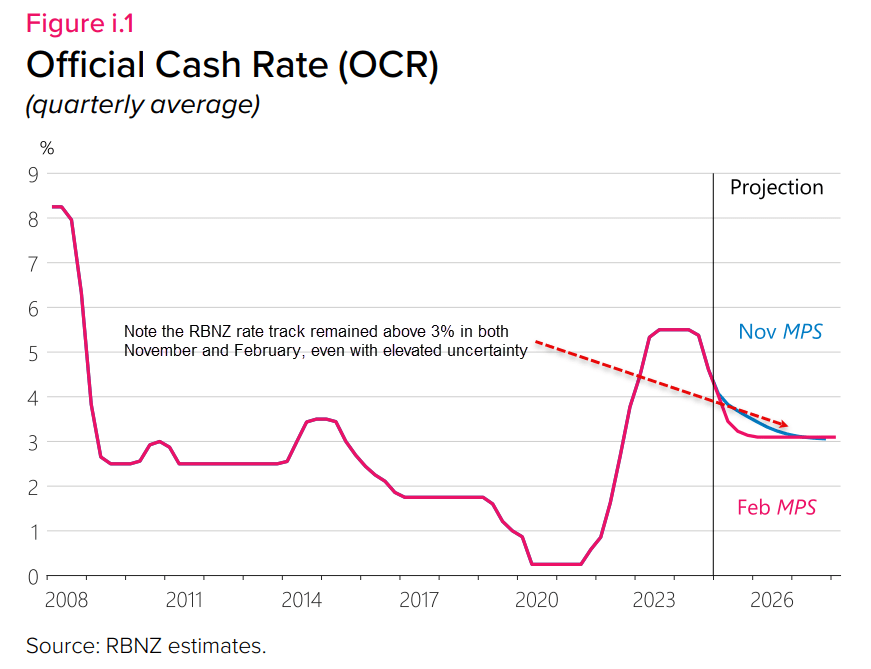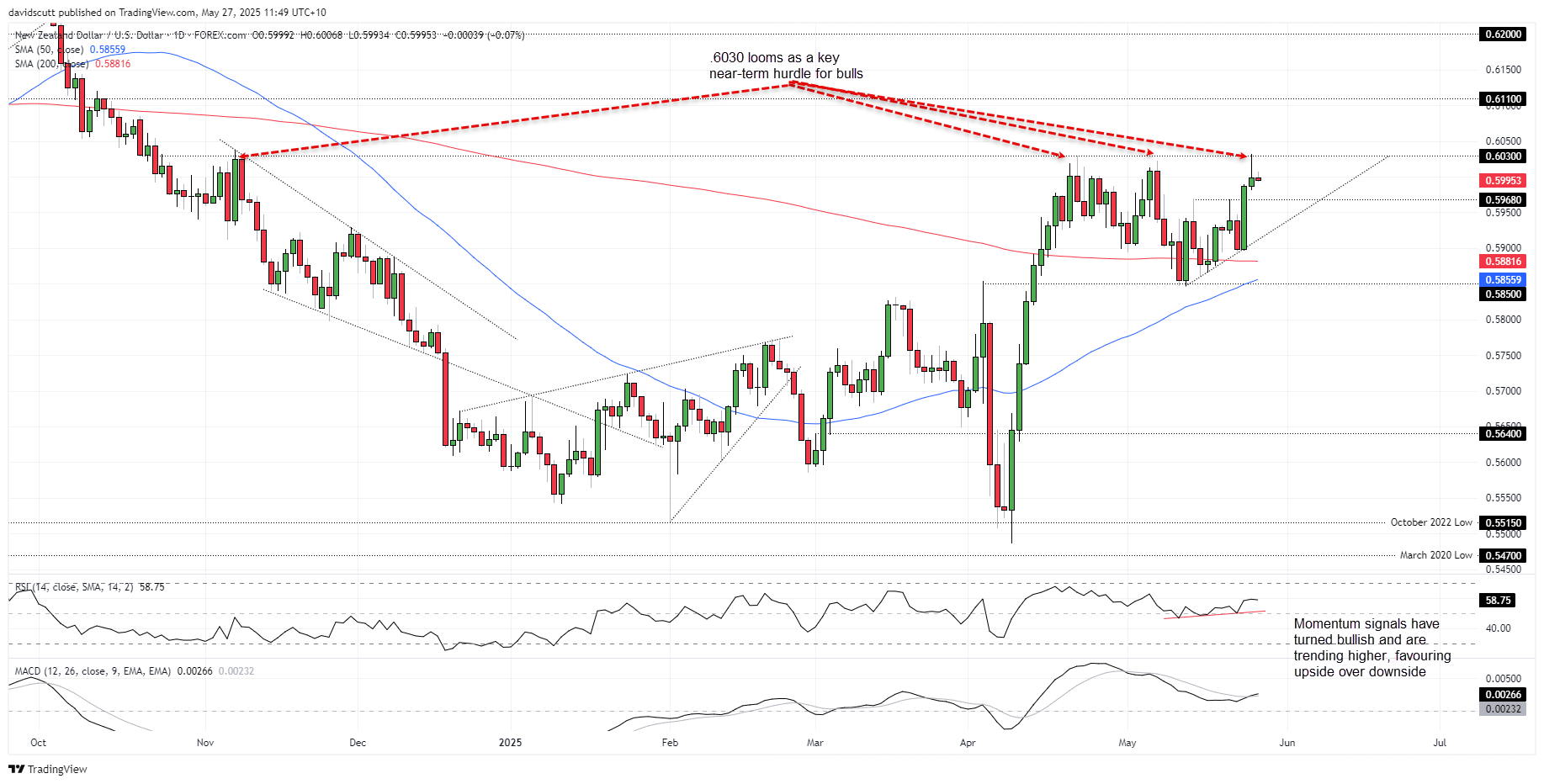
- RBNZ expected to cut 25bp to 3.25%
- Markets see cash rate falling below 3% this year
- Q1 data soft but not weak enough to guarantee multiple cuts
- Kiwi dollar may rise if the bank’s track isn’t dovish enough
- NZD/USD momentum signals still point higher
Summary
The Reserve Bank of New Zealand (RBNZ) is expected to continue lowering interest rates at its May policy meeting, with a 25 basis point reduction in the cash rate to 3.25% deemed a lock. In the absence of a shock outcome, the New Zealand dollar will likely be driven by the bank’s updated forecasts, especially its outlook for the cash rate. With markets pricing a move below 3% later this year—under the 3.1% rate the RBNZ forecast three months ago—directional risks for the New Zealand dollar may be skewed higher should the bank fail to deliver on dovish expectations.
Another RBNZ Meeting, Another Cut Expected
A 25 point reduction in New Zealand’s cash rate—taking total easing this cycle to 225 basis points—is considered a lock by markets, as seen in the graphic below from Bloomberg which calculates the implied probability of a cash rate movement based on swaps pricing.

Source: Bloomberg
At 25.4 basis points worth of cuts, pricing suggests there's a sliver of a chance being attached to another supersized 50 basis point reduction, although such an outcome looks highly improbable, especially after the scale of easing already delivered. Beyond the May meeting, a 25 basis point cut in July is seen as probable, with around a three-in-four chance attached. Further out, markets are also flirting with the idea of another cut, taking the cash rate below 3%.
RBNZ Rate Track Key for NZD Direction
Assuming the RBNZ goes 25, whether the bank forecasts additional cuts in its updated cash rate track will be key when it comes to directional risks for the Kiwi dollar. The track provided three months ago had the cash rate bottoming at 3.1%, implying a slightly higher probability of the cash rate reaching 3% rather than 3.25%.

Source: RBNZ
That forecast is less dovish than current market pricing heading into the May meeting, suggesting the RBNZ’s updated profile will likely need to at least meet those expectations—if not exceed them—to spark a meaningful downside move in the Kiwi. If not, the NZD could fly as traders are forced to reassess the rate outlook.
New Zealand Economy Remains Weak
The snapshot below provides a high-level look at how the New Zealand economy performed in Q1, with the RBNZ’s prior forecasts shown in red.

Source: TradingView
Headline inflation and GDP both came in a tenth above forecast, while the unemployment rate was a tenth under, hinting there is a risk the RBNZ may not lower its rate profile—even though the data in outright terms remains soft. However, private sector wage growth has been weak relative to expectations. Oil prices also undershot substantially, while the Kiwi dollar in trade-weighted terms has surprised on the upside, suggesting medium-term risks to inflation may be lower, not higher.
A lot will come down to how the RBNZ assesses elevated uncertainty attached to U.S. trade policy and its potential impact on both the domestic and global economy. It was enough for the RBNZ’s colleagues at the RBA to turn dovish earlier this month, but that came from a central bank in the infancy of its easing cycle—not one as advanced as the RBNZ.
RBNZ May Fail to Meet Dovish Expectations
The view remains unchanged that the path of least regret for the RBNZ will be to take the cash rate to at least the 2.5% region this cycle, especially with little help coming from the fiscal side. Labour market conditions are weak, with falling participation and higher underutilisation. The economy is not growing at a sufficient pace to absorb new workers, keeping the outlook for wages—and domestic-sourced inflation—soft at best.
But with the RBNZ singularly focused on inflation given that’s its mandate, it may need to be convinced by data—not assumptions—before taking monetary policy into outright stimulatory territory. With inflation expectations also starting to lift, it would not surprise if the RBNZ’s updated rate track is not as dovish as current market pricing. If correct, the New Zealand dollar could catch a bid following the rate decision.
NZD/USD Upside Favoured

Source: TradingView
NZD/USD briefly touched year-to-date highs on Monday, lifting to levels last seen immediately after the U.S. presidential election before reversing lower. While the inverted hammer candle from .6030 warns of downside risks, it formed during extremely thin trade with U.S. and U.K. markets closed for public holidays, questioning the reliability of the signal.
With MACD crossing the signal line above zero and RSI (14) trending higher above 50, momentum signals are bullish, favouring upside over downside.
Resistance is found at .6030, .6110 and .6200. Support at .5986, .5900, the 200DMA and .5850.
For those trading around the RBNZ meeting, the decision and monetary policy statement will be released at 2pm in Wellington (Midday AEST). Acting Governor Christian Hawkesby will address the media from 3pm onwards (1pm AEST).
-- Written by David Scutt
Follow David on Twitter @scutty






